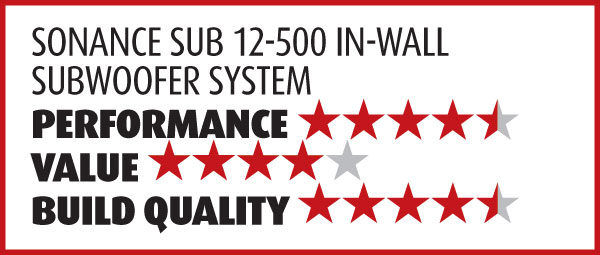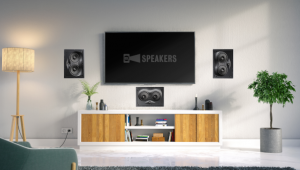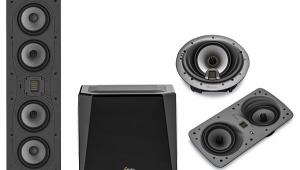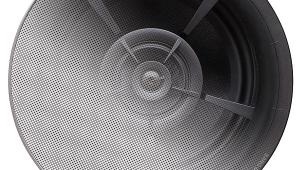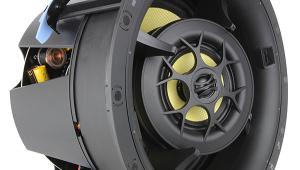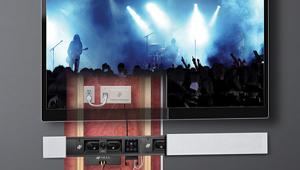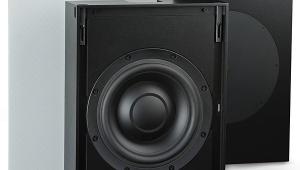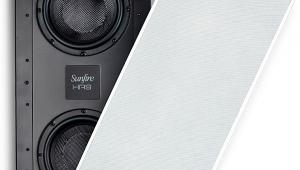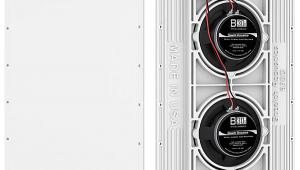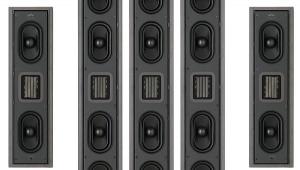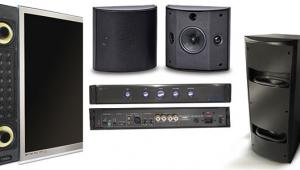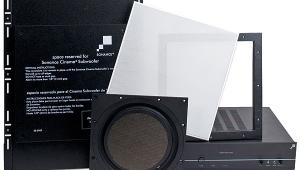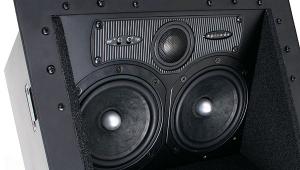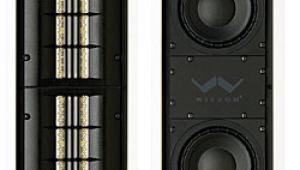Sonance SUB 12-500 In-Wall Subwoofer System Page 2
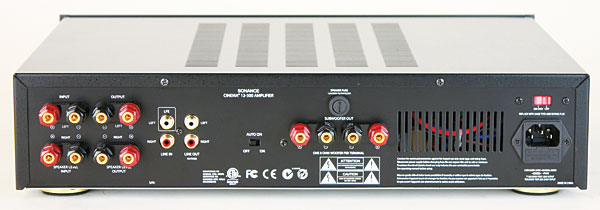
Screw This
Installation is about as straightforward as you can get. There
are almost two-dozen holes along the length of the steel rails on the outside of the back box, so you can screw the box down to the studs so tight it’ll never dream of moving. The box ships with a blank plate installed where the woofer will eventually go, so the drywall guys can finish the wall all the way up to the plate—although they shouldn’t tape and float
over the opening. Once the wall treatment has been applied (paint, wallpaper, faux adobe, gold leaf, etc.), just remove the blank plate and slide the woofer into the empty space. Twelve screws snug the woofer up against the box. (I’m telling you, this thing is built like a brick sh—, I mean, outhouse.) Twenty-four small, round magnets are aligned on the outer flange of the speaker basket. These powerful little pucks grab onto the 15-inch square steel grille and just about won’t let go. (In this case, being a cling-on is a good thing.) A 15-inch white square grille
on your wall certainly won’t be invisible, but the perforations
are small and the flange is
narrow so it has a classy appearance that will look fine with most décors. There’s always the option of painting it to match the wall, too.
Bolt Me Up, Zombie
You might want to install the Cinema SUB 12-500 in a plainly obvious location—and maybe put a sign on it that reads, “Subwoofer,” because it won’t be long before people start asking where all that bass is coming from. I can’t say that this fine in-wall subwoofer is totally as awesome
as a $3,000 in-room sub might
be, but precious few in-wall subs can match their in-room price equivalents (except for maybe the BG BGX-4850 in-wall subwoofer system, reviewed in our January 2010 issue, but that one costs about $7,000). With the limitations imposed by the need to fit the subwoofer cabinet in a 2-by4 opening and the desire to keep the grille size as small as possible, it’s difficult to get the same performance as you would from
a subwoofer with no such limitations.
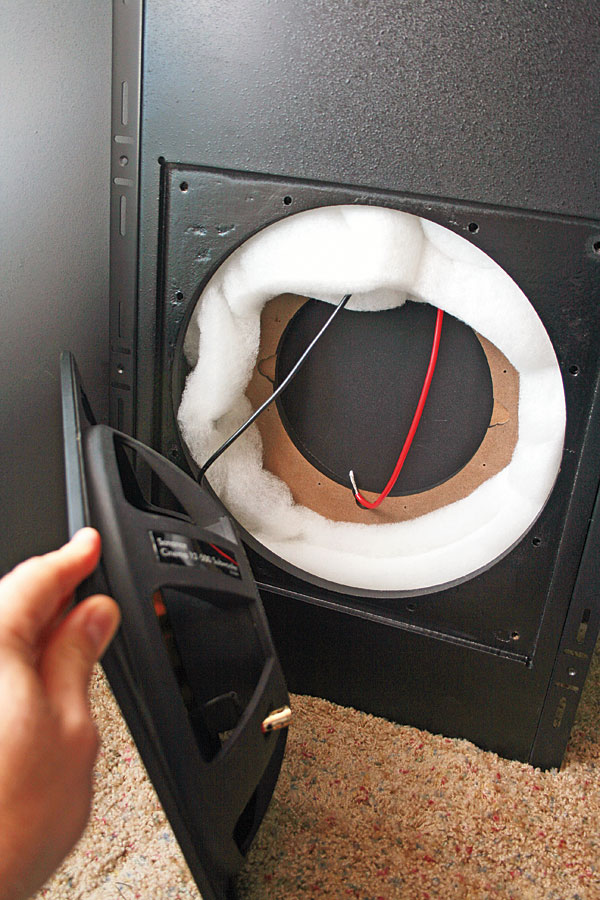
Don’t let the previous paragraph lead you to think that the Cinema SUB 12-500 isn’t good. It’s very good and more than worth the cash if you want or need an in-wall subwoofer with some hefty meat on its bones. For example, in the movie Up, during the scene in which Muntz’s dog pack is chasing Carl, Russell, Dug, and Kevin (all toting the floating house) through the canyon, the sub reproduced the low-bass impact of the falling boulders and rock outcroppings very viscerally. The very educational movie Zombieland, in addition to providing plenty of good old-fashioned zombie violence, also puts the sub to the test near the end of the movie as the zombies overrun the Los Angeles theme park. Not only are the gun blasts as authentic as any zombie-blasting gun blasts can be, but the low-bass beats that are part of this scene’s musical underpinning are tight and tense. Perhaps my favorite performance by the Cinema SUB 12-500 was during the first several minutes of Bolt when Bolt and Penny appear in their starring roles for the first time. The pounding bass beat beneath the action never lets up, and neither did the subwoofer. (It got pleasantly warm, but I wouldn’t say it ever got up to 1,330 BTU.) The sub really came into its own during the helicopter chase scene that starts on the bridge and results in much loud, destructive entertainment.
I used the subwoofer with my Legacy Harmony in-wall speakers. They’re certainly large enough to run full range, but I set the crossover in my Sunfire surround processor to 80 Hz to see how the Cinema SUB 12-500 would blend with them. With both movies and music, I noticed that the Sonance sub is fast and musical. I got tired of my normal musical selections, so on a lark (actually, I rode in my car), I checked with my local music store to see what music they might recommend to put a subwoofer to the test. The first disc I came home with was from a band called For Today (a Christian rock band), which the guy who helped me described thus: “It’s wholesome and it’s heavy metal” with “some serious bass drops.” I’m not anti–Christian heavy metal, but I’m not a fan, either. In this case, though, the bass on several of the songs, including one called “King,” darn near made me see Jesus thanks to the Cinema SUB 12-500. While it didn’t hit those 20-Hz notes that turn your internal organs to Jell-O and make the joints in your furniture come unglued, this Sonance sub will easily cause you to believe in a higher power when it comes to filling your room with bass. I cranked the system very loud for extended periods of time without pushing the sub into audible distortion (that wasn’t meant to be there). Another recommended disc was from the French duo, Justice, whose music Amazon describes as being “crazy-quilt dance-pop hybridism.” The song “One Minute to Midnight,” which at times seems to be one long (but surprisingly listenable) bass drop, came through strong and flawless on the Cinema SUB 12-500.
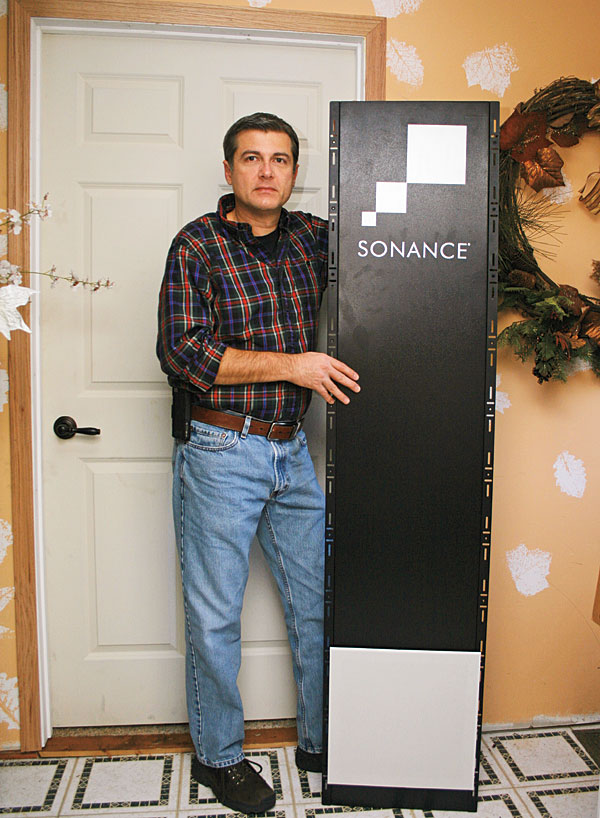
It’s easy to recommend this subwoofer because Sonance has done so many things right with it. For example, they did a good job isolating the back box to minimize resonances that’ll transfer to the wall. In addition, the SUB 12-500 driver itself is a serious transducer that can move some serious air. I also think the amp’s ability to run one or two subwoofers is a nice cost saver for anyone who wants to run things a little louder than the normal person or who has a larger-than-average room. Just as impressive is the fact that—unlike some subs that tend to have a bump at a particular frequency—the Sonance sub’s response is free of noticeable peaks and dips.
All in all, the Sonance Cinema SUB 12-500 is an extremely impressive package that will do a heck of a job for anyone who wants to put bass into their room without compromising space or décor. The technology behind it may not be as exciting to talk about as subs that fold space and time and fit in a two-gang junction box, but I’ll take good old-fashioned engineering that performs like this any day.
